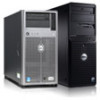Dell PowerEdge 4100 Service Manual - Page 12
SCSI ID Numbers, Device Termination
 |
View all Dell PowerEdge 4100 manuals
Add to My Manuals
Save this manual to your list of manuals |
Page 12 highlights
SCSI ID Numbers Each device attached to the 7860 Ultra/Narrow SCSI host adapter must have a unique SCSI ID number from 0 to 7. For additional SCSI addressing information, see Chapter 10, "Installing Drives in the Internal Bays," in the Installation and Troubleshooting Guide. When narrow SCSI devices are shipped from Dell, the default SCSI ID numbers are assigned as follows: • The computer's built-in Ultra/Narrow SCSI host adapter is configured through the BIOS as SCSI ID 7. • A SCSI CD-ROM drive (installed in an externally accessible drive bay) is configured as SCSI ID 5. • A SCSI tape drive (if installed) is configured as SCSI ID 6. NOTE: There is no requirement that SCSI ID numbers be assigned sequentially or that devices be attached to the cable in order by ID number. Devices attached to the Ultra/Wide SCSI host adapter need no ID settings or termination; ID settings and termination are handled automatically by the SCSI backplane. Device Termination SCSI logic requires that termination be enabled for the two devices at opposite ends of the SCSI chain and disabled for all devices in between. Therefore, regardless of whether you are installing internal or external devices, use the following guidelines: • A single SCSI device (such as the standard CD-ROM drive) is terminated. • If two or more SCSI devices are installed, connect the devices as follows: - Attach one of the devices to the end connector on the SCSI cable, and leave the terminator enabled on that device. - The other end of the SCSI cable connects to the computer's built-in Ultra/Narrow SCSI host adapter or to an optional SCSI host adapter card, which needs no termination. - Disable the terminators on all other devices you attach to the cable. The standard SCSI CD-ROM drive is configured as the last device on the SCSI cable. Therefore, any additional devices attached to the cable should have their terminators disabled. See the documentation provided with the SCSI device for information on disabling the device's terminator. 1-10 Dell PowerEdge 4100/180 and 4100/200 Systems Service Manual















